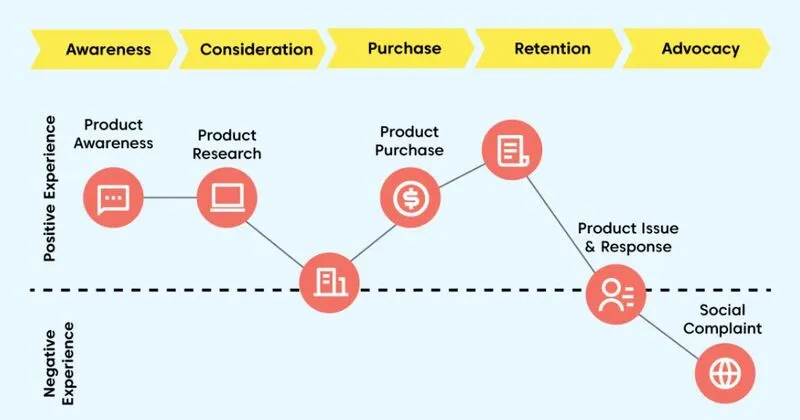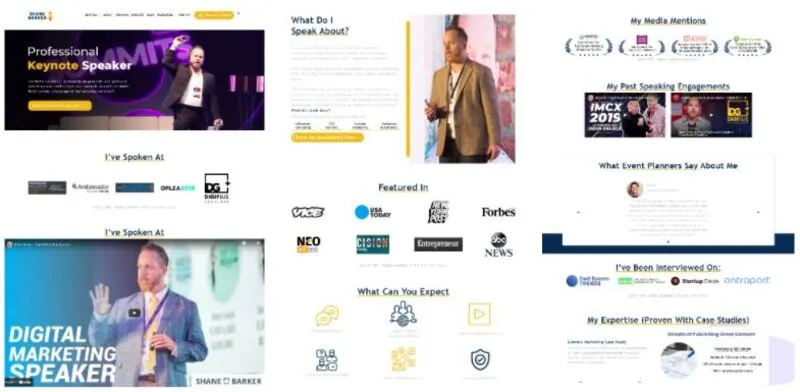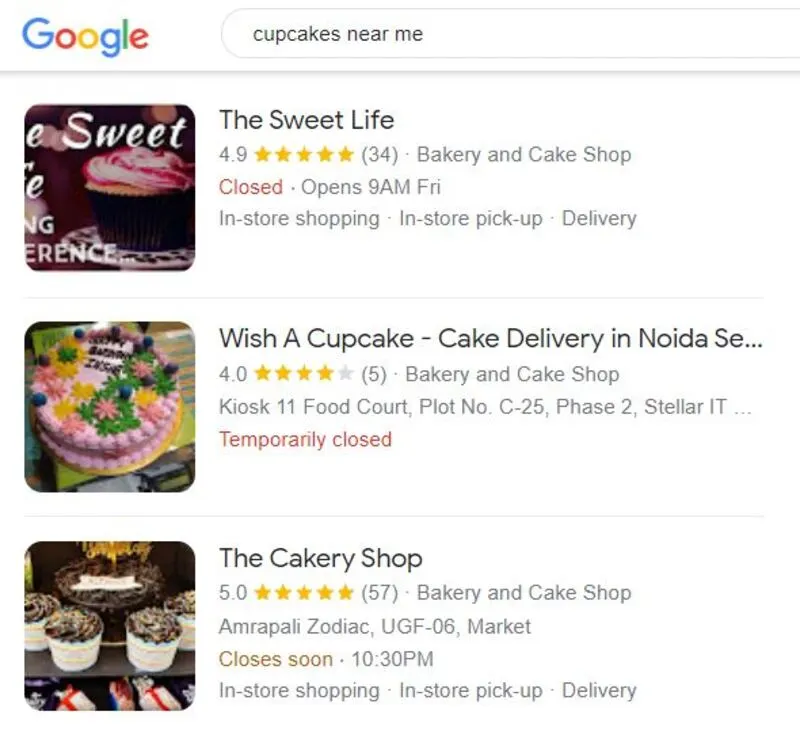Marketing refers to the practice of identifying and satisfying the needs of your current and prospective customers.
It is especially important within business contexts because successful advertising can drive leads into a large customer base, which, in turn, will help you generate more sales and revenue.
While marketing is deeply rooted in the business culture, digital marketing is a comparatively new approach. As technology boomed, businesses started exploring new advertising methods to attract customers. This is how digital marketing began to take root.
Want to learn what digital marketing is all about, why it matters, and how you can use it to your advantage? Then, read on!
Table of Contents
What is Digital Marketing?
Digital marketing is the process of promoting your business, products, and services using digital channels to reach and engage customers and encourage sales. There are many aspects to this, including email marketing, social media advertising, search engine optimization (SEO), mobile marketing, and more.
In practice, digital marketing typically refers to marketing campaigns that appear on a computer, mobile phone, tablet, or other electronic devices.
Social media posts, video ads, display advertisements, podcasts, and Google ads are some of the many methods you can use to digitally market your business.
Digital Marketing vs. Online Marketing
Though most people confuse digital marketing with online marketing, these two terms are not the same.
Online marketing is simply using the internet to promote or sell your products or services. It includes social media marketing, search engine optimization, content marketing, and more.
Digital marketing, on the other hand, is an umbrella term that encompasses all online as well as offline activities involved in promoting products and services using digital channels.
This includes marketing through search engines, mobile devices, social media, email, television, digital billboards, and any digital channel that may be introduced in the future.
In all, you can say that online marketing is a subset of digital marketing.
Image source: nomwebsolution
Why Does Digital Marketing Matter?
How many of us read newspapers today? Or, how much time do we spend looking at the print ads and billboards on our way?
Not as much as we spend time browsing stuff on electronic devices such as mobile phones and tablets, right?
If you refer to statistics, people now spend an average of 482 minutes every day with digital media in the United States. At the same time, print advertising is declining.
With more people using digital channels to consume information, digital marketing provides businesses with a unique opportunity to connect with their target audiences in a way that is both convenient and personal.
In addition, it’s easy to track the impact of all of your digital marketing efforts, unlike traditional marketing. You can track user behavior, engagement, and other key metrics to better understand your customers and the ways they like to interact with your brand.
Analyzing what works for them and what doesn’t will help you optimize your digital marketing strategy from time to time to improve your customer service and create a more positive customer experience.
These are a few of the many reasons why digital marketing matters for every business that wants to continue engaging customers and generating sales.
It's important to remember, though, that not everyone is using the same channels, so you'll need to tailor your digital marketing approach accordingly.
For example, if most of your target market is on Facebook, then you'll want to focus on using Facebook Ads. But if your audience is more likely to be performing searches on Google, then it will make more sense for you to invest in SEO.
7 Benefits of Digital Marketing
There are many benefits to using digital marketing for your business. Here are a few of the most important ones:
- Reach a larger audience: With so many people using the internet and social media, it's easier than ever to reach a much wider audience through digital channels than you could through traditional methods.Digital marketing provides you with a greater opportunity to connect with your target audience and generate more leads and sales.
- Build a brand: Leveraging different digital marketing channels such as websites, social media, and SEO make it easy for businesses to define what their brand is all about. It also helps you attract a targeted consumer base that is likely to be interested in your content and products/services.
- Personalize your messaging: Digital marketing allows you to personalize your messages by using data collected about customers. This information can help you target your advertising strategy and content more effectively, which is likely to result in higher returns on investment (ROI).
- Track your results: It is easy to track the results of your digital marketing campaigns, so you can determine what's working and what isn't. You can also use this data to improve your future campaigns.With digital marketing, you get access to instant feedback, which allows you to adjust your campaigns as needed to prevent any further monetary or reputation losses.
Cost-effective: Digital marketing is often more cost-effective than traditional marketing techniques, such as print advertising.
- Easier access to information: The internet has made it easier than ever for people to access information. This has led to an increase in the use of digital marketing, as businesses can now easily reach out to a large number of potential customers who spend lots of time with their electronic gadgets every day.
- Flexibility: With digital marketing, you can easily change your marketing messages and strategies in response to customer feedback and changing market conditions. In addition, the content you create can be tailored to meet the needs of your audience, which wasn’t possible with traditional marketing tactics.
However, leveraging digital marketing requires continuous learning. That's because the field of digital marketing is constantly evolving as new technologies and platforms become available.
It is important for businesses and marketers to keep up with these changes and stay up-to-date with the latest techniques, technologies, and tools to stay relevant, effective, and always ahead of the competition.
For example, the use of chatbots is becoming more widespread recently. As a marketer, you need to be aware of how chatbots can be used to drive engagement, sales, and customer loyalty for your business.
Most successful brands are using chatbots across all touchpoints in the customer journey, which is resulting in increased sales, positive customer experiences, and great branding.
Want to use digital marketing to your advantage in the business world?
I’ve got a pro tip for you: Keep reading, keep learning, and keep experimenting with the latest digital marketing strategies and tools to see what works best for you!
Also read: Digital marketing strategies for startups
11 Types of Digital Marketing (Digital Marketing Channels)
Now that you know the advantages of using digital marketing, let's take a look at the different types of digital marketing channels:
Website and/or Blog
The first step to taking your business online is to set up a website or a blog. Whether you want to create an online presence for your company or you want to provide information about your products or services, building a website is your best bet.
It can help you attract new customers and build relationships with existing customers. Additionally, you can use it to increase brand awareness, engagement, and your chances of generating sales and revenue.
However, before building a website or blog for your business, you should ask yourself:
- What are your goals for the site?
- What kind of information do you want to provide?
- Who is your target audience?
- What is your budget?
- How much time can you dedicate to creating your business website?
If you can answer these questions, you'll be in a better position to decide how to get started.
Here are some tips for creating a business website or blog:
- When building a website or blog, it’s important to choose the right platform and design. Most small businesses choose WordPress as it is easy to use and offers many useful themes, features, and plugins.You can use other popular website builders as well.
- Be sure to think about the overall design and layout when picking a website theme. It should be visually appealing and make it easy for users to navigate.
- Make sure the content is easy to read, relevant to your target audience, interesting, and easy to understand.
- Add social media buttons so people can easily share your content, products, and services with their friends and followers.
- Optimize your website for page loading speed, mobile responsiveness, search engines, and conversions to make the most out of this digital marketing platform.
- Use high-quality product images and videos on your website. Don’t forget to show your product from different angles and use multiple types of shots.
Other than design and optimization, it is also important to ensure that each of your web pages offers all of the information a visitor may need to take action.
For example, my Speaking page has all the information an event planner or company will need to know before hiring me as a speaker for their summit or conference.
This page mentions my past experiences as a speaker, the topics I speak about, case studies to show my expertise in influencer marketing, SEO, and other areas, and much more.
You may think there is no need to invest in a website when you can promote your business on social media and through forums or email for free. But there are some drawbacks to channels that you don’t own.
What if you build a solid presence on Instagram but the platform shuts down one day, just like Orkut did?
All of your brand-building and digital marketing efforts invested on the platform will have been in vain and you’ll be back to square one. Whereas, your website or blog will be your own space in the digital world.
Once you build an audience that likes your content and offers, they’ll continue to come back to your website until you shut down your business yourself.
In addition to this, you can design and develop your website any way you want and will not be restricted to the features a specific platform provides. Just be sure to put in the time and effort to make it a useful and enjoyable space for visitors!
Search Engine Optimization (SEO)
Search engine optimization, or SEO, is a process of optimizing a website to make it rank higher on search engines like Google and Bing. It includes optimizing on-page elements such as website content, structure, titles, metatags, and anchor text as well as off-page elements like your link profile and social media engagement.
You’ll also need to optimize your website for technical SEO factors such as page speed, image file size, and backend code.
Wondering why it is important for businesses to invest in SEO?
Well, 53% of U.S. shoppers research a product on a search engine before making a purchase. And, the majority of clicks are limited to page one of Google while the second page receives only 0.78% of all clicks.
If you want to order a cupcake, you are likely to search “cupcakes near me” and click on the bakeries listed in the top-ranking results to see what each of them has to offer.
If the top results on search engines offer what you need and have received decent reviews from other customers, you’ll most likely order from them, there and then. This means that even if another bakery sells better quality cupcakes, it may not receive as many orders as the top-ranking ones.
Moreover, SEO is more cost-effective than other digital marketing tactics. It provides long-term results, which means you can continue to see returns on your investment over time.
Let’s take a look at some of the best SEO practices you should follow to make your business rank well in relevant search engine results.
- Choose the right keywords. When picking keywords for your business, think about what your customers would type into a search engine to find your business. Make sure to target long-tail keywords that are specific to your industry, services, and geo-location.
- Optimize your website for SEO by using the right keywords in page titles, meta descriptions, content, and URLs, and by following the best practices for website design and structure.
- Publish high-quality content on your website, including blog posts, product pages, ebooks, and landing pages. This content will help you to rank well in search engine results and it will also help establish your business as an authoritative source in your industry.
- Promote your content on social media and through email newsletters and other digital marketing channels to help it reach a wider audience.
- Monitor your results using the best analytics tools to see what’s working and what needs improvement.
- Make changes as needed. If you find that your website isn’t ranking well in search engine results, make changes to your SEO strategy as needed.
Following these best practices will help you improve your website’s visibility in search engine results and increase your website traffic.
Pay-Per-Click (PPC) Advertising
Pay-per-click (PPC) advertising is the process of bidding on keywords to get your ads displayed when people search for those keywords.
PPC is a great way to get immediate traffic to your website and you only pay when someone clicks on your ad. It's one of the best techniques to target users who are already interested in the products or services you have to offer.
Though PPC can provide faster results, it is more expensive than other digital marketing methods. Therefore, you need to plan your PPC budget and campaign strategy cautiously.
Let’s take a look at a few tips that can help you run successful PPC campaigns.
- Know your target audience. What are their demographics? What are their interests? What keywords are they likely to use when searching for what you’re selling? Once you know this, you can focus your ads on targeting those specific users.
- Research your competition. What are their ads like? What keywords are they targeting? What’s the click-through rate (CTR) of their ads? By researching your competition, you can get a good idea of what works and what doesn’t, and then you can adjust your own ads accordingly.
- Have a clear goal in mind before you start your PPC campaign. Do you want to generate more leads? Increase website traffic? Sell more products? Only when you know what you want to achieve will you be able to better tailor your campaign to meet those goals.
- Determine your budget. One of the biggest mistakes people make when running a PPC campaign is not setting a budget. You need to set a limit on how much you’re willing to spend on each click, and then stick to it.If you don’t, you could quickly blow through your budget and end up with nothing.
- Add words or phrases that you don’t want your ads to be shown for to the negative keywords list. It can help you save a lot of money.For example, if you’re selling car wash services, you might add the keyword “free” to your negative keyword list, since you don’t want your ads to show up for people who are looking for free car washing services.
- Test and optimize your PPC campaigns for different keywords, ad copy, and bidding strategies to find out what works best for your industry and business. And be sure to regularly track your results so that you can make changes as needed.
Content Marketing
Content marketing is the process of creating and publishing content to promote a product or service and build awareness for the brand.
The goal here is not only to attract customers but also to retain them by providing valuable information in an entertaining way that ensures they will be coming back again when needed.
One common way to approach content marketing is to create content relevant to your industry and business in the form of blog posts, videos, infographics, or social media posts. This could also involve creating interactive posts, contests, or giveaways that encourage users to engage with the brand.
No matter what approach you use, it's important to make sure that the content is high quality and provides value for the target audience. If it's not interesting or helpful, then it's likely that people will not bother coming back.
You should be consistent when it comes to content publishing and you should also use keywords and hashtags to reach a wider audience.
When leveraging content marketing, you should also test different content formats and ideas to see what works best for your business.
Looking for a successful content marketing example for inspiration?
Here you go:
Blogger and entrepreneur, Adam Enfroy, started writing content to help other bloggers and businesses make money online. What started as just another blog on the internet has grown to be a million-dollar business for him, all through content marketing.
The key to successful content marketing is creating quality content that actually helps your audience do something better or faster.
Here’s how to create and implement an effective content marketing strategy for your business:
- Determine what you want to achieve with your marketing efforts before you start creating content. Do you want to increase brand awareness, drive website traffic, or generate leads? Once you know your goals, you can create content that aligns with them.
- Create a content calendar to better plan and organize your content creation efforts. It can include the topics you want to cover, target dates for publishing, and even a rough outline of the content itself.This will help ensure that your content is published regularly and that it’s consistent with your overall digital marketing strategy.
- Produce high-quality content that’s relevant, valuable, and engaging for your audience. It also means using correct spelling and grammar, and ensuring that your content is high-quality from a design perspective.
- Promote your content. Content promotion is an essential part of getting it seen by the right people. You can promote your content through social media, email marketing, and paid advertising. You can also embed it on your website or blog and submit it to popular industry directories.
- Track the effectiveness of your content. Use analytics tools to measure how much traffic it’s generating, what types of people are engaging with it, and how it’s impacting your bottom line.
You can use this data to adjust your content marketing strategy as needed.
By following these steps, you can create a successful content marketing strategy for your business and get ahead of the competition.
Email Marketing
Email marketing is the process of sending marketing messages to your subscribers, prospects, and existing customers through email.
It is one of the most effective ways to reach out to consumers and promote your business. It allows you to stay in touch with your customers, keep them updated on new products or services, and build customer loyalty.
You can also use email marketing to build relationships with potential customers and encourage sales. When users visit your website as a result of an email campaign, they are more likely to buy something or sign up for your mailing list.
It's best to send emails regularly, but not too often, or you'll risk annoying your subscribers.
Here are a few dos and don’ts of running a successful email marketing campaign:
Dos of Email Marketing:
- Make sure that your email marketing content is relevant to your audience.
- Keep your messages brief and to the point, and write them in clear, concise language.
- Write catchy subject lines that will capture people’s attention and compel them to open your emails.
- Test different subject lines, content, and email designs to see what works best.
- Personalize your messages whenever possible.
- Use images and graphics to break up the text and make your emails more visually appealing. You can also use interactive elements to increase user engagement.
- Keep your email design simple and easy to read.
- Use clear call-to-action (CTA) buttons and links.
- Monitor your email marketing results and optimize your campaigns accordingly.
Don’ts of Email Marketing:
- Don’t use spammy tactics such as buying lists or sending unsolicited emails.
- Don’t bombard your subscribers with too many messages.
- Don’t use unprofessional or salesy language.
- Don’t use unrelated content or links.
- Don’t make it difficult for people to unsubscribe from your list.
- Don’t neglect to test your content and subject lines.
- Don’t use too much text without any images or graphics.
- Don’t use complex or hard-to-read fonts.
- Don’t make your CTA buttons difficult to find or confusing to use.
- Don’t forget to follow up with subscribers after they’ve clicked on your CTA.
Email marketing can be a great way to connect with your audience and promote your business, but it’s important to remember to follow these dos and don’ts to ensure success.
By keeping these tips in mind, you can create effective and engaging email marketing campaigns that will reach your target audience and help boost your business sales and revenue.
Many digital marketers use email not only to acquire new customers but also to encourage repeat orders from existing customers. One brand that excels at using email marketing throughout the customer lifecycle is Sephora.
From welcome emails to cart abandonment recovery messages, post-purchase emails, product replenishment reminders, and custom triggers, Sephora sends all types of emails to constantly engage their prospects and customers.
Here’s an example of Sephora trying to re-engage and win their customers back by offering them a time-bound discount:
You can also create a similar customer lifecycle-centric email program using powerful email marketing automation tools and CRM solutions.
Social Media Marketing
Social media marketing is the process of using social media platforms like Facebook, Twitter, and LinkedIn to promote your products or services.
Consumers today are highly reliant on social media for product information and reviews. So it's important that your business has a strong social media presence to make sure your marketing messages reach these consumers.
You should post regularly, and you should also use hashtags to reach a wider audience. You can also use social media advertising or paid ads to boost the reach of your top-performing social media posts.
Looking for more tips to do social media marketing effectively? Here you go:
Use high-quality visuals. People are visual creatures, so including great visuals in your social media posts is a must. This could include photos, infographics, or videos.
Keep your posts short and sweet because most people won’t read long paragraphs on social media.
Make use of hashtags relevant to the topic of your post. Hashtags are a great way to reach a wider audience and to show up in relevant search results.
Include a strong call-to-action. Your social media posts should always include a call-to-action, whether it’s to visit your website, sign up for your email list, or buy your product or service.
Monitor your social media analytics to find out what's working and what's not. Making changes to your strategy as needed is the key to improving the returns of your marketing efforts.
There you have it! Some helpful tips for doing social media marketing effectively. For more tips and advice, be sure to check out my infographic on how to boost your social media campaign ROI.
Also, check out the social media marketing tools that can help you.
Affiliate Marketing
Affiliate marketing is a process of partnering with other websites and/or people to promote your products or services. You can do this by placing a link or banner on their website, or by providing them with custom-made advertising materials.
When someone clicks on that link or banner, they are redirected to your website, where they can learn more about your products or services and potentially make a purchase.
Affiliate marketing is a cost-effective way to increase traffic to your website as you only pay your affiliate when they help you generate leads or sales.
In addition to partnering with affiliates to promote your products or services, you can also become an affiliate marketer and promote other businesses. It can be a very lucrative way to earn additional income.
There are many different affiliate marketing programs available, so it's important to research and choose the one that best suits your business.
There are a few things to keep in mind when choosing an affiliate marketing program:
- It should offer a commission rate that is competitive with other programs.
- It should have a wide range of products and services to choose from.
- It should be reliable and should offer support and training to help you succeed.
If you're looking for an affiliate marketing program that meets all of these criteria, I recommend the Amazon Associates Program. It's one of the largest and most reputable programs available, and it offers a commission rate of 10-15% depending on the product niches/industries you choose.
Some of the other popular affiliate networks that can help you discover profitable affiliate programs are:
- ShareASale
- CJ Affiliate (formerly Commission Junction)
- Rakuten LinkShare (formerly LinkShare)
- ClickBank
- AvantLink
- Pepperjam
- Awin
- WEBGAINS
There are many different affiliate marketing programs to choose from, and it can be difficult to decide which one is right for you. That's why I've compiled a list of the three most important criteria to look for when choosing an affiliate marketing program.
- The first criterion is the size and reputation of the program. It's important to choose a program that is large and reputable so you can be confident that you're promoting a quality product.
- The second criterion is the commission rate. The commission rate is the percentage of the sale price that you will earn as a commission. Look for a program with a commission rate of at least 10-15%.
- The third criterion is the product niche/industry. It's important to choose a program that offers products in your niche or industry. This will ensure that you are promoting products that are relevant to your audience.
Pro tip: If you want to earn a good passive income as an affiliate marketer, always choose the quality of the product over the commission its brand is offering.
Why? Because your audience will only trust you if you offer valuable, high-quality content and recommendations to them. None of them will return to you after buying a cheap product you promoted.
I have been collaborating with many SaaS companies myself to promote their tool subscriptions but only when I’m satisfied with the tool’s features and efficiency. Some examples of powerful digital marketing platforms that I can vouch for at any time are Semrush, Surfer, and Constant Contact.
Influencer Marketing
Influencer marketing is the process of partnering with influential people to promote your products or services. You can do this by working with bloggers, social media stars, or other industry experts.
When you partner with an influencer, you get access to their audience. In addition, their audience is more likely to trust and heed recommendations from the influencer instead of ads from your brand.
Influencer marketing is, therefore, one of the easiest and quickest ways to build trust and credibility and get found by wider audiences who are likely to buy your products or services.
The key to making influencer marketing work in your favor is to find the right influencers to work with. Not everyone is a good fit for your brand, so you need to carefully select your influencers.
Here are a few things you can do to find the right partners:
- Use social media listening tools to track specific keywords and phrases, as well as the conversations happening around them. This can help you find people who are already talking about your brand or products.
- Check out industry blogs and forums as these places are filled with people who are passionate about certain topics.
- Use Google Search to find relevant bloggers and social media stars.
- Perform searches on social media platforms such as Instagram using your niche-specific hashtags such as “#fashion” or “#fitness” as well as for advertising-related hashtags such as “#ad” and “#sponsored.”
Once you've found a few potential partners, it's important to vet them thoroughly before working with them. You should look at their audience size, engagement levels, and the type of content they produce.
Also, make sure their values align with your own. You don't want to work with someone who promotes harmful or unethical practices.
Once you've selected your influencer, it's time to determine in which ways you want to partner with them. You can:
- Work with them to produce sponsored content.
- Run a joint contest or giveaway.
- Ask them to take over your brand’s official social media accounts for a day to attract their followers to your profile.
- Or, make them the face of your brand by signing a long-term partnership with them. Do this only when you’ve vetted and worked with them in the past and you absolutely trust them with your brand’s reputation.
No matter how you decide to work with an influencer, be sure to track the results of their marketing efforts so you can see how well they're performing. This information will help you decide whether or not to continue working with them in the future.
Here’s how much partnering with influencers will cost, in general.
Many brands also combine influencer marketing with affiliate commissions to encourage influencers to drive more sales to their businesses. When an influencer will also get a commission for every sale they generate, they are likely to give it their best.
Moreover, offering an affiliate discount code can also help the influencer provide more value to their audience along with generating more sales for your business.
One brand that excels at leveraging the perfect combination of influencer and affiliate marketing is Daniel Wellington.
Here's one such post in which an influencer offers a unique discount code for purchasing Daniel Wellington watches to her followers:
Along with increasing sales, the brand also uses unique affiliate codes to track the performance of each of their affiliates.
The bottom line is that influencer marketing is an effective way to reach a wider audience, build trust and credibility, and drive sales. However, it can only be a successful strategy for your brand if you partner with the right influencers.
Also, check out:
- The latest influencer marketing trends
- Why influencer marketing is better than celebrity endorsements
Mobile Marketing
Mobile marketing is the process of using mobile devices like smartphones and tablets to promote your products or services.
It is the wave of the future. If you're not using mobile, your customers are likely leaving you behind. Moreover, customers are more likely to convert on a smartphone than they are on desktop browsers, and most of them spend at least a few hours per day browsing their phones!
Here are some tips to do mobile marketing right:
- Optimize your website for mobile viewing.
- Make sure your marketing materials are easy to read on a small screen and don't forget to include a call-to-action in all of them.
- Use geo-targeting to send personalized messages to customers in specific areas.
- Leverage push notifications to grab people's attention when they're not actively using their phones.
- And above all, test, test, test! Make sure you're constantly tweaking your mobile marketing campaigns to make sure they're as effective as possible.
There are many ways to use mobile devices for marketing purposes, and the best way to find out what works for you is to experiment. Try out some of these tips and see how your customers react. And most importantly, keep track of your results so you can learn and improve over time.
TV Advertising
TV advertising is the process of marketing a product or service by airing commercials on television. Television advertising has been around since the late 1940s, and it is now the most common form of advertising.
There are many different types of TV commercials, but most fall into one of four categories:
- Product promotion: This type of commercial promotes a specific product or service.
- Brand promotion: This type of commercial promotes a brand, rather than a specific product or service.
- Cause-related marketing: This type of commercial promotes a charity or social cause.
- Entertainment advertising: This type of commercial is designed to entertain viewers, rather than promote a product or service. It helps brands build awareness and stay on top of the minds of their prospective customers.
TV advertising can be a very effective way to reach consumers. However, it is important to make sure that your commercials are well-made and engaging, or you risk losing viewer attention.
Additionally, it is important to target your commercials correctly, so they reach the right audience. This can be done by using demographic targeting, which is when a company uses information like age, gender, and location to target their commercials to certain viewers.
Another way TV advertising can be targeted is by using behavioral targeting, which is when a company uses information like past website visits or purchase behavior to target their commercials.
TV advertising can be an expensive investment, but it is often worth the cost. The average American spends most of their time watching television, averaging about 3.1 hours per day, so there is a lot of potential for exposure. And, because TV advertising is so common, it can be very effective in getting your message across to potential customers.
There are many different ways to create TV commercials, and the process can be a bit daunting for first-timers. However, by following a few simple steps, you can create a commercial that is both effective and engaging.
- The first step is to come up with a good idea for your commercial. This can be difficult, but it is important to make sure that your commercial is interesting and relevant to viewers.
- The next step is to storyboard your commercial. This involves sketching out each scene of your commercial and writing down the dialogue and narration. This will help you visualize your commercial and make sure that it is properly planned out.
- Once you have your storyboard complete, it is time to start filming. This can be done with a simple video camera, and you can either shoot the footage yourself or hire a professional crew.
- Once you have your footage, it is time to put together your commercial. This involves editing the footage and adding music and graphics. You can do this yourself with some basic editing software, or you can hire a professional to do it for you.
- Finally, once your commercial is complete, it is time to air it on TV. This can be done by contacting local TV stations and negotiating a price.
By following the steps outlined above, you can create a commercial that is both effective and engaging. And, by targeting your commercial correctly, you can reach the right audience and get the most out of your investment.
Enhanced Billboards Advertising
What’s the difference between a billboard placed across a random road and a billboard in New York City’s Times Square?
All of the billboards in Times Square are electronic. The massive, LED-lit digital screens and billboards compete for attention with 360,000 pedestrians visiting each day.
No denying that it’s one of the most desirable ad spaces in the world and has seen some of the most creative digital advertising moments ever.
Then, there are interactive electronic billboards that encourage interaction with your audience and help businesses boost user engagement.
For example:
To promote its “Have a Break” campaign, KitKat installed billboards in Colombia that would vibrate when people leaned against them, providing them with a relaxing massage.
How to Do Digital Marketing Effectively
Digital marketing is one of the most efficient and effective ways to reach and connect with your target audience on a more personal level, which can result in more conversions and sales.
However, doing digital marketing effectively can be a little tricky. Here are some steps and tips you can follow to get started:
Define Your Goals
The first step in any effective digital marketing campaign is to define your goals. What do you want to achieve with your marketing efforts? Do you want more website traffic, more leads, more conversions, or something else?
Once you know what you want to achieve, you can better tailor your campaigns and strategies to reach those goals.
Identify and Understand Your Target Audience
The second step is to identify and understand your target audience. Who are you trying to reach with your digital marketing campaigns? What are their interests and needs?
Knowing your target audience is essential for creating effective content and marketing messages that will resonate with them. You can also use this information to better target your advertising and outreach efforts.
Leverage Multiple Digital Marketing Strategies (Free & Paid)
There is no one-size-fits-all approach to digital marketing, so it’s important to use a variety of strategies to reach your target audience.
Some of the most popular digital marketing strategies include:
- SEO
- Paid advertising
- Content marketing
- Social media marketing
- Email marketing
- Affiliate marketing
- Influencer marketing
- TV advertising
- Enhanced billboards advertising
You can use any or all of these strategies to reach your target audience, depending on your goals and budget.
Create Relevant, Engaging Content for Your Customer Base
One of the most important things you can do to make the most out of your digital marketing efforts is to create useful, relevant, and engaging content. This content can be in the form of blog posts, articles, videos, infographics, etc.
The more useful and interesting your content is, the more likely people are to read it, share it, and take action on it.
Track Key Metrics to Measure Your Digital Marketing Performance
Digital marketing is a constantly evolving landscape, so it’s important to constantly test and measure the effectiveness of your marketing efforts to see what’s working and what’s not.
This will help you fine-tune your campaigns and strategies by making necessary adjustments to get even better results.
Use analytics tools to track website traffic, leads, conversions, and other key metrics to measure your digital marketing performance.
Optimize Your Campaigns to Maximize Returns
Just tracking results is not enough. It's important to use the insights from various analytics tools to optimize your campaigns to get the most out of them.
This includes using the right channels, targeting the right people, and creating relevant and engaging content.
By following these steps, you can do digital marketing effectively and achieve better results for your business.
The Role of Digital Marketing in Building Brands
Digital marketing is one of the most efficient and effective ways to build a brand. It involves the use of electronic media and digital technologies to reach and engage customers.
It can be done through a variety of channels, including websites, social media, email, and mobile apps.
One of the biggest advantages of digital marketing is that it allows businesses to target a specific audience. With the help of analytics tools, businesses can track the success of their digital marketing campaigns and make necessary adjustments.
Digital marketing is also a cost-effective way to reach customers. It requires minimal investment in comparison to traditional marketing methods such as print advertising.
Overall, digital marketing has become an essential part of the marketing mix for most businesses as it provides businesses with the ability to target a specific audience, track campaign success, and save money.
What Does a Digital Marketer Do?
A digital marketer is responsible for promoting a company's products or services through a variety of digital channels. This includes the use of websites, social media, email, and mobile apps.
The main responsibility of a digital marketer is to create and implement effective marketing campaigns that reach a wide audience. They also track the success of these campaigns and make necessary adjustments to improve the campaign ROI.
Digital marketers must also be knowledgeable about the latest digital technologies and how they can be used to promote a business. They must also be able to use analytics tools to track the success of their campaigns.
Digital Marketing FAQs
1. What is digital marketing?
Digital marketing is a marketing technique used by brands to reach potential customers through the use of the internet. It includes using channels such as websites, search engines, email, social media, and mobile.
2. How do I become a digital marketer?
There is no one-size-fits-all answer to this question, as the best way to become a digital marketer may vary depending on your skills, experience, and education.
However, here are some tips on how to become a digital marketer:
- Enroll yourself in a reputable digital marketing course. You can find some of them here.
- Gain experience in different streams of digital marketing by working as an intern in a digital marketing agency.
- Pick a digital marketing tactic that you are interested in and have gained knowledge of. It could be SEO, social media marketing, or email marketing.
- Build a portfolio of your work done for different projects and clients.
- Network with other digital marketers and learn from their experiences.
- Continuously learn and stay up-to-date with the latest changes in the digital marketing landscape.
The best way to become a successful digital marketer is by having a combination of skills, experience, and education. So if you are looking to make a career in digital marketing, start by doing research on the best courses and pursuing relevant internships.
Once you have some experience under your belt, focus on honing your skills in one specific area of digital marketing, and continue to learn and keep up-to-date with the latest changes.
By following these steps, you will be well on your way to becoming a successful digital marketer.
Digital Marketing in 2022 and Beyond
Thanks for reading! I hope this article gave you a good overview of what digital marketing is, why it matters, and some of the things you need to consider if you want to start using it.
Digital marketing, undoubtedly, offers a lot of opportunities for businesses of all sizes. There's no one-size-fits-all approach, so it's important to test and experiment until you find the right channels and strategies that will work best for your business.
In the latter sections of this article, you’ll also learn how to get started with digital marketing and which strategies to use to accelerate the growth of your business in 2022 and beyond.
If you have any questions about using digital marketing to your advantage, feel free to leave them in the comments section and I'll get back to you.











Related Articles
What is Digital Marketing? Everything You Need to Know
Best Blogger Outreach Tool – 21 Tools to Minimize Your Outreach Efforts
33 Free Google Marketing Tools for Marketers and Developers
22 Best Online PR Tools to Build and Monitor Media Relations
Digital Marketing for Startups: The Strategies to Use in 2024